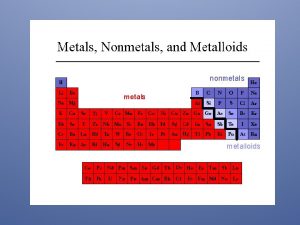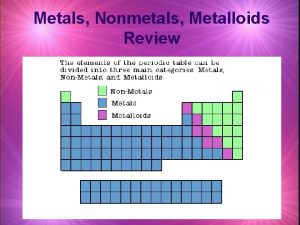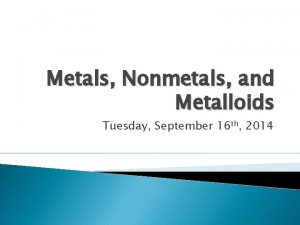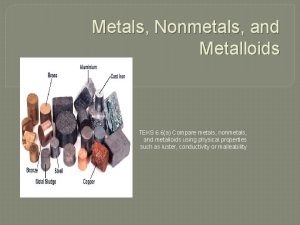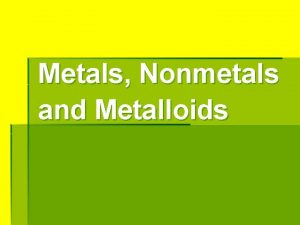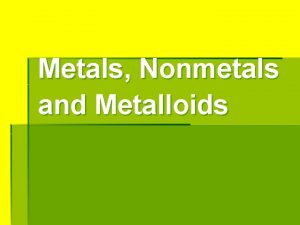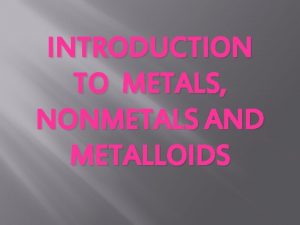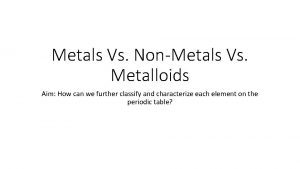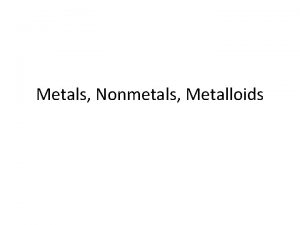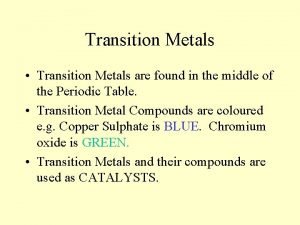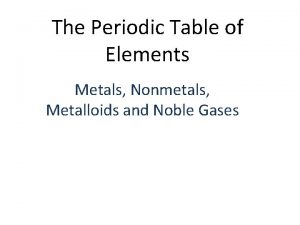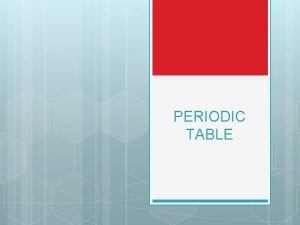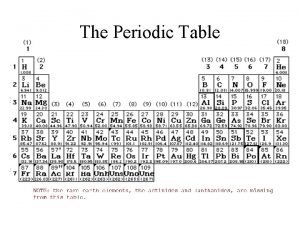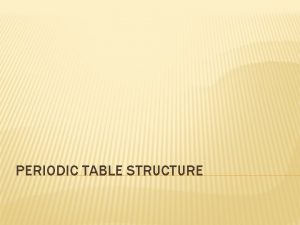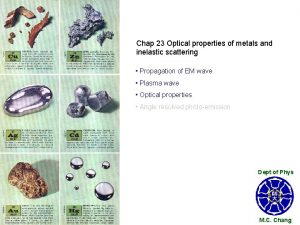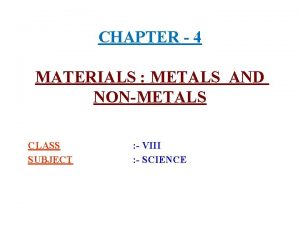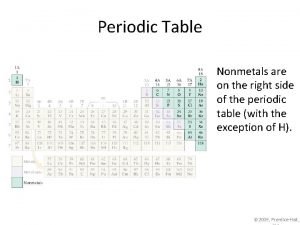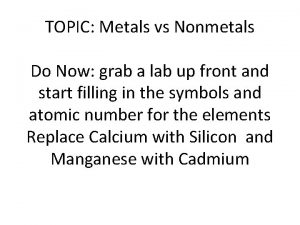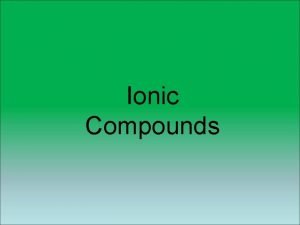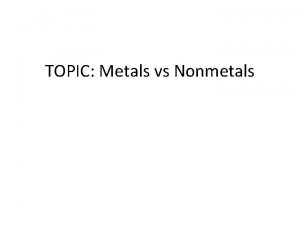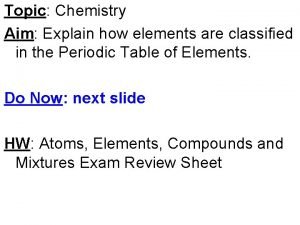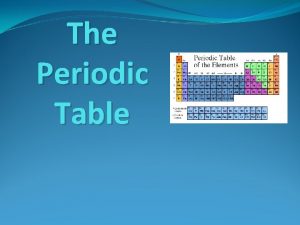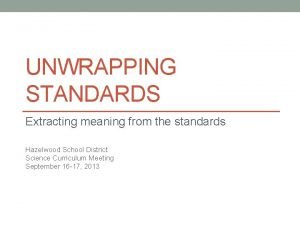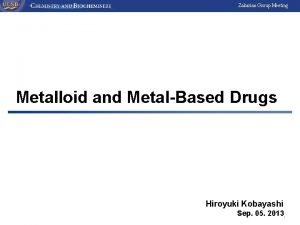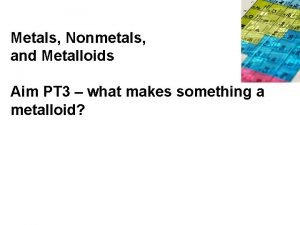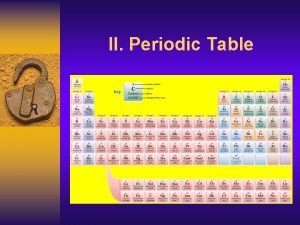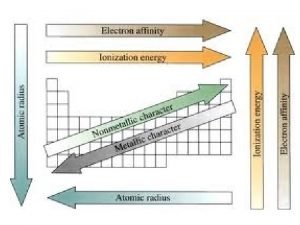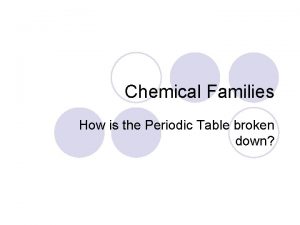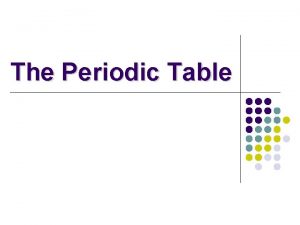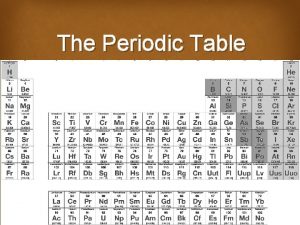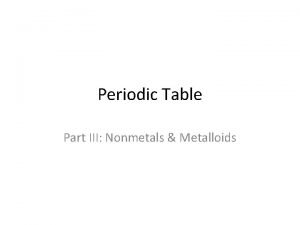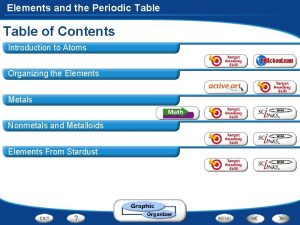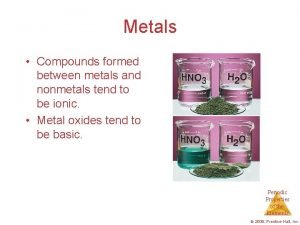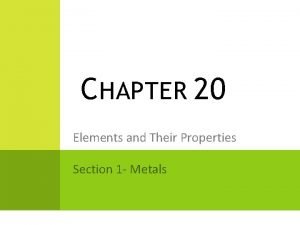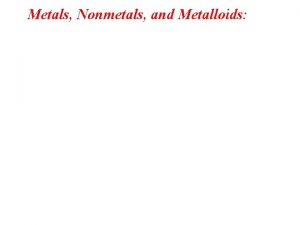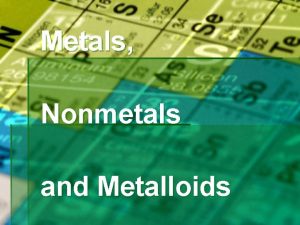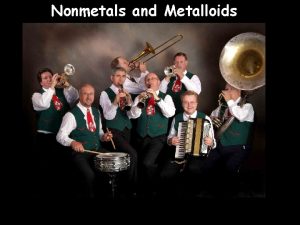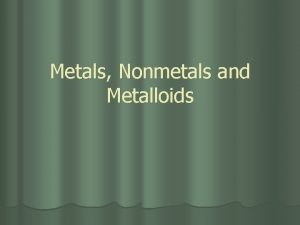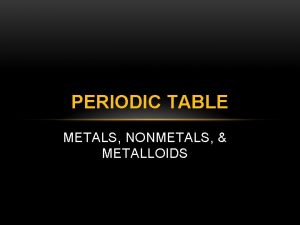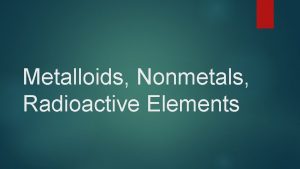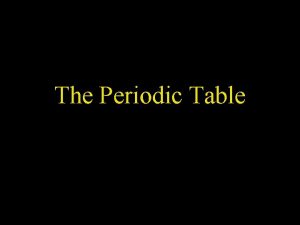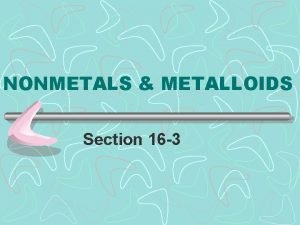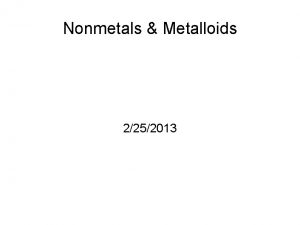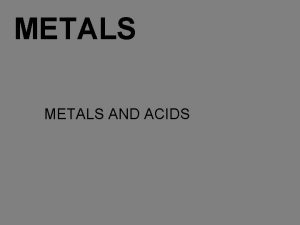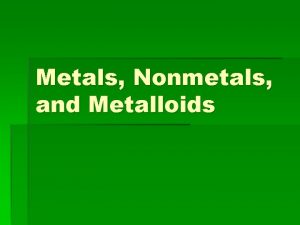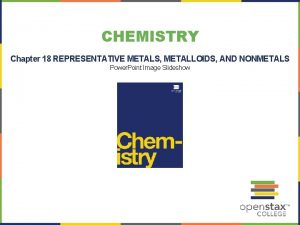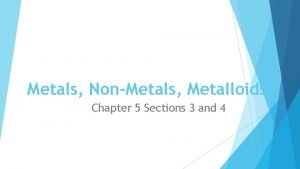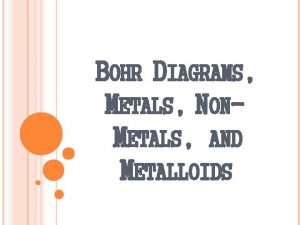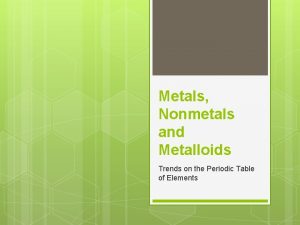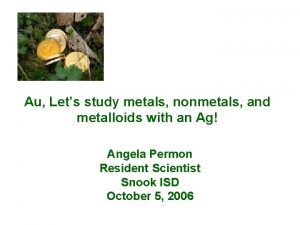METALS AND NONMETALS ELEMENT METALS METALLOIDS NONMETALS Overview


















































- Slides: 50

METALS AND NON-METALS ELEMENT METALS METALLOIDS NONMETALS

Overview of the Chapter Metals - Physical properties Non-metals - Physical properties Metals - Chemical properties Reaction of metals with oxygen Reaction of metals with water Reaction of metals with acids Reaction of metals with solutions of other metal salts Reaction of metals with non-metals Properties of ionic compounds Occurrence of metals Rectivity series Extraction of metals of high reactivity Extraction of metals of medium reactivity Extraction of metals of low reactivity Refining of metals Corrosion of metals Prevention of corrosion

Elements Ø Science has come along way since Aristotle’s theory of Air, Water, Fire, and Earth. Ø Scientists have identified 92 Natural elements, and created about 28 others.

Elements The elements, alone or in combinations, make up our bodies, our world, our sun, and in fact, the entire universe.

The most abundant element in the earth’s crust is oxygen.

Properties of Metals appear to the left of the dark ziz-zag line on the periodic table. Most metals are temperature. solid at room

Physical Properties of Metals

Malleable Metals can be hammered into sheets

Ductile Ductility: Drawn into thin wires. Most ductile: Gold/ aurum Au, silver/ argentum Ag. One gram of gold can be drawn into a wire of 2 km length

Conductor Conduction of heat: Good conductors of heat; have high melting points. Silver Ag and copper/ cuprum Cu best conductors of heat. Lead/ plumbum Pb and mercury poor conductors of heat Conduction of electricity: Good conductors of electricity. Electric wires are made of Cu having a outer insulation of PVC (polyvinyl chloride)

Conductor � Metals are good conductors of electricity. Copper, silver, and gold are good electrical conductors. In a conductor, electric current can flow freely. Since metals have free electrons, they can carry a charge easily. Copper Wiring

When you leave a spoon in a cup of hot drink, the bit poking out of the drink gets hot. Why? Conduction! METALS are the best conductors of heat. This is because the electrons in metals move more freely than in non-metals, allowing the heat energy to travel across the metal. For example, when the spoon touches the hot drink, the heat from the drink excites the electrons in the metal, and the electrons transfer the energy from one electron to another, carrying the heat all the way up the spoon quickly. Best conductors: silver and copper

Lustre: Shine in their pure state, polished to give a highly reflective surface

Solids � Solids: At room temperature. � Exceptions: Mercury/ hydrargyrum Hg and gallium Ga are in liquid state at room temperature

Melting point and Boiling point: High. Tungsten/ wolfram W highest melting point; sodium Na and potassium K low melting points

Sonorous: Produce a sound on striking a hard surface e. g. bells

Hardness � Hardness: Generally hard, differs from metal to metal. � Alkali metals like sodium Na and potassium K are soft metals and can be cut easily with a knife

PHYSICAL PROPERTIES OFNON-METALS Ø Either in solid or gaseous state. Exception: Bromine Br is in liquid state Ø Usually do not have lustre. Exception: Iodine I Ø Do not possess the property of hardness. Exception: Carbon C in the form of diamond. It is the hardest substance known which also has a high melting and boiling point Ø Do not conduct electricity. Exception graphite (allotrope of carbon)

Metalloids � Metalloids possess both the properties of metals as well as non-metals e. g. silicon Si, germanium Ge, antimony/ stibium Sb, etc.

Metalloids

Physical properties of metals METALS- Malleable and Ductile Electric conductive Tensile Alloy formation Lustrous Sonorous

CHEMICAL PROPERTIES OF METALS Reaction of metals with oxygen � Almost all metals react with oxygen to form metal oxide, but the reactivity differs for different metals � Sodium and Potassium are the most reactive metals. � Sodium reacts with oxygen in air at room temperature to form sodium oxide. Hence, sodium is stored under kerosene oil to prevent its reaction with oxygen, moisture and carbon dioxide � 4 Na + O 2 → 2 Na 2 O

Reaction with oxygen : Metals react with oxygen to form metal oxides. When copper is heated it combines with oxygen to form copper oxide. 2 Cu + O 2 2 Cu. O When aluminium is heated it combines with oxygen to form aluminium oxide. 4 Al + 3 O 2 2 Al 2 O 3 Some metal oxides are basic oxides because they react with water to form bases. 4 Na + O 2 2 Na 2 O + H 2 O 2 Na. OH K + O 2 K 2 O + H 2 O 2 KOH Some metal oxides show acidic and basic properties. They are called amphoteric oxides. Aluminium oxide, Zinc oxide etc. Al 2 O 3 + 6 HCl 2 Al. Cl 3 + 3 H 2 O (basic) Na. Al. O 2 + H 2 O Al 2 O 3 + Na. OH (acidic) (Sodium aluminate)

Chemical properties of metals i) Reaction with oxygen : - � Metals react with oxygen � When copper is heated it to form metal oxides. combines with oxygen to form copper oxide. 2 Cu +O 2 2 Cu. O � When aluminium is heated it combines with oxygen to form aluminium oxide. � 4 Al + 3 O 2 2 Al 2 O 3 � Some metal oxides are basic oxides because they react with water to form bases. � 4 Na+ O 2 2 Na 2 O

The reactivity of different metals with oxygen is different Metals like potassium and sodium react vigorously with oxygen and catch fire if kept in open. Hence they are stored in kerosene to prevent burning. � If magnesium is heated, it burns with a bright flame. If iron is heated it glows brightly. � If copper is heated it does not burn but forms a black coating of copper oxide. � Silver and gold does not react with oxygen even at high temperature. � Some metals like magnesium, aluminium, zinc, lead etc. forms an oxide layer over it which prevents further oxidation. They are called self protecting metals. •

Amphoteric oxides Metal oxides are usually basic in nature but some metal oxides such as aluminium oxide Al 2 O 3 and zinc oxide Zn. O react both with acids as well as bases to produce salt and water Al 2 O 3 + 6 HCl → 2 Al. Cl 3+ 3 H 2 O Al 2 O 3 + 2 Na. OH → 2 Na. Al. O 2(sodium aluminate) + H 20


ii) Reaction with water : Metals react with water to form metal oxides or metal hydroxides and hydrogen. 2 Na +2 H 2 O 2 Na. OH + H 2 2 K + H 2 O Ca + H 2 O 2 Al + 3 H 2 O 3 Fe + 4 H 2 O 2 KOH + H 2 Ca(OH)2 + H 2 Al 2 O 3 + H 2 Fe 2 O 3 + 4 H 2

Reaction of metals with water Metals like potassium and sodium react vigorously with cold water Sodium reacts with water to evolve hydrogen which immediately catches fire producing a lot of heat (Exothermic reaction) 2 K + 2 H 2 O → 2 KOH + H 2 + heat energy 2 Na + 2 H 2 O → 2 Na. OH + H 2 + heat energy

The reactivity of different metals with water is different : �Sodium and potassium react violently with cold water to form sodium hydroxide and hydrogen and catches fire. �Calcium reacts less violently with water to form calcium hydroxide and water and does not catch fire. �Magnesium reacts only with hot water to form magnesium hydroxide and hydrogen. �Metals like aluminium, iron and zinc react only with steam to form the metal oxides and hydrogen. �Metals like lead, copper, silver and gold do not react with water.

Reaction of Na with water

Calcium reacts with water less vigorously. The heat evolved is not sufficient for hydrogen to catch fire Instead, calcium starts floating because the bubbles of hydrogen gas formed stick to the surface of the metal Ca + 2 H 2 O → Ca(OH)2 + H 2 Magnesium reacts with hot water to form magnesium hydroxide Mg(OH)2 and hydrogen H 2. Magnesium also starts floating since the bubbles of hydrogen gas stick to its surface.

Metals like aluminium, iron and zinc do not react either with cold or hot water but they react with steam to form metal oxide and hydrogen (g) 2 Al + 3 H 2 O → Al 2 O 3 + 3 H 2 3 Fe + 4 H 2 O → Fe 3 O 4 + 4 H 2 Metals like gold, silver, and copper do not react with water at all

Reaction of metals with acids Metals react with acids to give salt and hydrogen gas Reaction with dilute hydrochloric acid HCl Formation of metal chloride and hydrogen gas The reactivity decreases in the order, Mg > Al > Zn > Fe Mg + 2 HCl → Mg. Cl 2 + H 2 ↑ 2 Al + 6 HCl → 2 Al. Cl 3+ 3 H 2 ↑ Zn + 2 HCl → Zn. Cl 2+ H 2 ↑ Fe +2 HCl → Fe. Cl 2 + H 2 ↑ No bubbles are seen in case of copper. This shows that copper does not react with dilute hydrochloric acid

Reaction with Sulphuric acid (H 2 SO)4 Formation of metal sulphate and hydrogen gas Fe + H 2 SO 4 → Fe. SO 4(aq) + H 2(g) Iron Fe reacts vigorously and exothermically with sulfuric acid to produce iron (II) sulfate Zn + H 2 SO 4 → Zn. SO 4(aq)+ H 2(g) Mg + H 2 SO 4 → Mg. SO 4(aq) + H 2(g)

Reaction with Nitric acid (HNO 3) Hydrogen gas is not evolved when a metal reacts with nitric acid, as it is a strong oxidizing agent It oxidizes the hydrogen to water and itself gets reduced to any of the nitrogen oxides (N 20 nitrous oxide, NO nitric oxide, NO 2 nitrogen dioxide) But magnesium and manganese react with dilute HNO 3 to evolve hydrogen gas Mg(s) + 2 HNO 3(aq) → Mg(NO 3)2(aq) + H 2(g) magnesium + nitric acid → magnesium nitrate + hydrogen

Reactions of metals with air, water and acids Element Potassium K Sodium Na Reaction with Air Reaction with Water Burns vigorously With cold water forms to form oxides hydrogen gas and alkaline hydroxide solution. React with decreasing vigour down the series till Ca Calcium Ca Burn with Mg reacts with hot Magnesium Mg decreasing water to fomi Aluminium Al vigour down the magnesium hydroxide Zinc Zn series and hydrogen gas. For Al, Zn and Fe, no Iron Fe reaction with cold and hot water. With steam forms metal oxide and hydrogen gas Reaction with Acid Violent reaction to give hydrogen gas and salt solution React to form hydrogen gas and salt solution with decreasing vigour down the series

AQUAREGIA Aquaregia is a highly corrosive as well as fuming liquid and is one of the few reagents that is able to dissolve gold and platinum It is a freshly prepared mixture of concentrated hydrochloric acid and concentrated nitric acid in the ratio of 3: 1 Aqua regia (Latin, lit. "royal water" or "king's water") was so named by alchemists because it can dissolve the noble metals gold and platinum

Reactions of metals with solutions of other metal salts Put an iron nail in the solution of copper sulphate Fe(s) + Cu. SO 4(aq) → Cu(s) + Fe. SO 4(aq) metal A + salt solution B→ salt solution A + metal B The iron nail gets coated with a reddish brown colour copper and the blue colour of copper sulphate solution fades out In this reaction more reactive iron has displaced copper which is less reactive from the copper sulphate solution

This reaction is known as displacement reaction. The brown coating on the iron nail shows that copper is deposited on the iron nail by displacing iron The greenish colour of the solution in the test tube shows that Fe 2+ ions are present in the solution. This shows that iron is more reactive than copper, as Fe 2+ ions have displaced Cu 2+ ions from copper sulphate solution

A more reactive metal displaces a less reactive metal from its salt solution. (Displacement reaction) Magnesium displaces copper from copper sulphate solution. Mg + Cu. SO 4 Mg. SO 4 + Cu Zinc displaces copper from copper sulphate solution. Zn + Cu. SO 4 Zn. SO 4 + Cu Iron displaces copper from copper sulphate solution Fe + Cu. SO 4 Fe. SO 4 + Cu after 15 – 20 minutes

Anodisingis a process of forming a thick oxide layer aluminium. Aluminium develops a thin oxide layer of oxideexposed This aluminium oxide coat makes it to further corrosion. The resistance can be improved by making the oxide layer thicker In this technique aluminium article is used as an anode. Electrolyte used is dilute sulphuric acid. The anode reaction results in formation of a black coloured thin film of aluminium oxide on the surface

Anodising � Anodising is a process of making thick layer of aluminium. � This aluminium oxide coat makes it to further corrosion � This resistance can be imprved by making oxide layer thicker � In this technique aluminium article is used as an anode. Electrolyte used is dilute sulphuric acid. The anode reaction results in formation of a black coloured thin film of aluminium oxide on the surface of anode


By putting appropriate dyes in the electrolytic bath, coloured surface with decorative finish can be achieved Kitchen articles like anodised pressure cookers, anodised pans and also frames of sliding windows are the applications of anodising techniques

Reactivity series of metals The arranging of metals in the decreasing order of their reactivity is called reactivity series of metals. K - Potassium Most reactive Na - Sodium Ca - Calcium Mg - Magnesium Al - Aluminium Reactivity decreases Zn - Zinc Fe - Iron Pb - Lead H - Hydrogen Cu - Copper Hg - Mercury Ag - Silver Least reactive Au - Gold

4) How do metals an non metals react ? Metals : - lose electrons and become positive ions. So they are called electropositive elements. Eg : - The atomic number of sodium is 11, its electronic configuration is 2, 8, 1, it has 1 valence electron. It loses 1 electron and forms a sodium ion Na + Na AN = 11 EC = 2, 8, 1 Mg AN = 12 EC = 2, 8, 2 Na + + 1 e- 2, 8 Mg 2+ + 2 e- 2, 8 Non metals : - gain electrons and become negative ions. So they are called electro negative elements. Eg: - The atomic number of chlorine is 17, its electronic configuration is 2, 8, 7, it has 7 valence. It gains 1 electron and forms a chloride ion Cl Cl + 1 e. AN = 17 EC = 2, 8, 7 Cl - O + 2 e- O 2 - 2, 8, 8 -

5 a) Formation of sodium chloride molecule – Na. Cl Na . AN = 11 EC = 2, 8, 1 + xx Cl xx xx Na xx . x x. Clx xx Na. Cl AN = 17 EC = 2, 8, 7 The atomic number of Na is 11, its electronic configuration is 2, 8, 1, it has 1 valence electron, it loses 1 electron to form Na + ion. The atomic number of Cl is 17, its electronic configuration is 2, 8, 7, it has 7 valence electrons, it gains 1 electron to form Cl - ion. Then the attraction between the Na + ion and Cl - ion results in the formation of sodium chloride molecule – Na. Cl.

b Formation of Magnesium chloride molecule – Mg. Cl ) 2 Mg AN = 12 EC = 2, 8, 2 Cl + 1 e AN = 17 EC = 2, 8, 7 . Mg. x + Mg 2+ + 2 e - 2, 8 Cl 2, 8, 8 xx x Cl x xx xx x Cl x x xx 2+ Mg . Cl x xx xx x x Mg. Cl 2 The AN of Mg is 12, its EC is 2, 8, 2, it has 2 valence electrons, it loses 2 electrons to form Mg 2+. The AN of Cl is 17, its EC is 2, 8, 7, it has 7 valence electrons, it gains 1 electron to form Cl -. Then the attraction between Mg 2+ ion and 2 Cl - ions results in the formation of Magnesium chloride molecule – Mg. Cl.

6) Ionic compounds (Electrovalent compounds) : Ionic compounds are compounds formed by the transfer of electrons from a metal to a non metal. Properties of ionic compounds : i) They are formed by the transfer of electrons and are made up of ions. i) They are crystalline solids. ii) They have high melting points and boiling points. iii) They are soluble in water but insoluble in organic solvents (like petrol, kerosene etc. ) iv) They conduct electricity in molten state or in solution.
 Characteristics of metal
Characteristics of metal Metals metalloids and nonmetals periodic table
Metals metalloids and nonmetals periodic table Nonmetals vs metals periodic table
Nonmetals vs metals periodic table Bulletproof metal periodic table
Bulletproof metal periodic table Non metals
Non metals Metals vs nonmetals vs metalloids
Metals vs nonmetals vs metalloids Differentiate metals nonmetals and metalloids
Differentiate metals nonmetals and metalloids Classification of metalloids
Classification of metalloids Metals nonmetals and metalloids chart
Metals nonmetals and metalloids chart Metals vs nonmetals properties
Metals vs nonmetals properties Periodic table divided in metals nonmetals and metalloids
Periodic table divided in metals nonmetals and metalloids Poem about metals nonmetals and metalloids
Poem about metals nonmetals and metalloids Periodic table metals nonmetals metalloids noble gases
Periodic table metals nonmetals metalloids noble gases Labeled periodic table
Labeled periodic table Semi metals on periodic table
Semi metals on periodic table Least reactive non-metal
Least reactive non-metal Non metals melting and boiling points
Non metals melting and boiling points Non metals and uses
Non metals and uses Optical properties of metals and nonmetals
Optical properties of metals and nonmetals Chapter 4 materials metals and nonmetals
Chapter 4 materials metals and nonmetals Nonmetals on the periodic table
Nonmetals on the periodic table Metals vs nonmetals
Metals vs nonmetals Reactivity periodic trend
Reactivity periodic trend In reactions to form ionic compounds metals generally
In reactions to form ionic compounds metals generally Characteristics of metalloids
Characteristics of metalloids Regents periodic table
Regents periodic table When a metal reacts with a nonmetal the metal will
When a metal reacts with a nonmetal the metal will Matter in natural science
Matter in natural science Metals and non metals grade 5
Metals and non metals grade 5 Ferrous vs non ferrous
Ferrous vs non ferrous Boron periodic table
Boron periodic table Distinguish between a signal element and a data element.
Distinguish between a signal element and a data element. Where are metalloids located on the periodic table
Where are metalloids located on the periodic table Unwrapping the standards
Unwrapping the standards What are uses of metalloids
What are uses of metalloids Metalloids on pt
Metalloids on pt Which list of elements contains two metalloids
Which list of elements contains two metalloids Metalloid line
Metalloid line Chemical families on the periodic table
Chemical families on the periodic table Metalloids examples
Metalloids examples Lightly color all metals yellow
Lightly color all metals yellow Which list of elements contains two metalloids
Which list of elements contains two metalloids Metalloids examples
Metalloids examples Metalloids on the periodic table
Metalloids on the periodic table Signal element vs data element
Signal element vs data element Compounds formed between metal and nonmetals
Compounds formed between metal and nonmetals Anthanides
Anthanides Virusmax
Virusmax Data quality and data cleaning an overview
Data quality and data cleaning an overview Chapter 17 elements and their properties
Chapter 17 elements and their properties An overview of data warehousing and olap technology
An overview of data warehousing and olap technology


